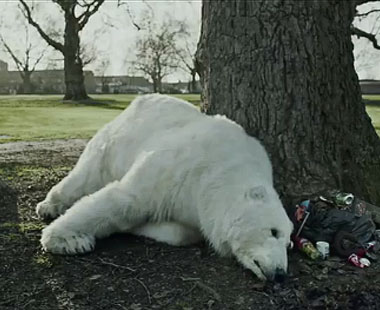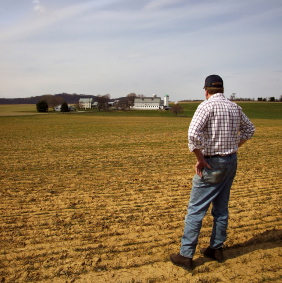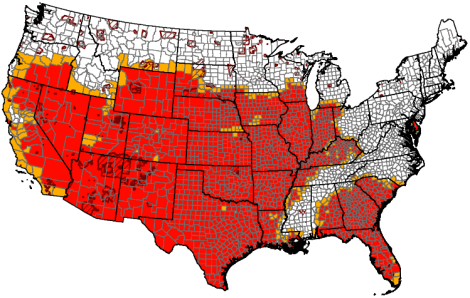OK, so this drought. I made a joke a while ago about how Gristmill could just turn into the all-drought headquarters ha ha ha because the drought was so bad. That was a month ago. Since then, the drought has gotten worse. It’s so bad now that the official law office of America should be Drought, Drought & Bobbitt — which is a real firm in San Antonio. San Antonio’s Bexar County, like every other county in Texas, is a disaster area due to drought. (Drought, Drought & Bobbitt is doing its part by representing oil companies.)
Anyway. Here’s America, as of yesterday [PDF]!
The red bits are the counties that have been declared disaster areas. It’s kind of like that game Pandemic, where everyone sees the plague creeping up on them. “Madagascar County has closed its borders.” That sort of thing. Seventeen states have been designated as disaster areas in their entirety, with Illinois and Iowa just succumbing this week. South Carolina is near full contagion; Minnesota is looking south with a tangible sense of concern.
Because the situation is so remorselessly and unrelentingly dire and because there is so much of it, we figured we’d create our own drought-assessment index, which ranks a slew of news stories on several key metrics.
Weather.com: “Drought Rises in Historical Rankings“
Summary: The drought is getting worse, now covering more area than all but four other droughts.
Key quote:
The intensity of this year’s drought continued to worsen as well. The percentage of the country in “severe” to “extreme” drought increased from 32.7% in June to 37.6% in July.
In these more serious categories, the 2012 drought grew from the 10th-largest on record in June to the sixth-largest in July, but still trails the 2002 drought in terms of the area covered in severe to extreme drought.
Maps and charts: 4
Images of farmers or crops: 0
Cause for concern (10 being highest): 6
New York Times: “Hundred-Year Forecast: Drought“
Summary: An opinion piece in which it’s argued that widespread drought is the “new normal.”
Key quote:
Future precipitation trends, based on climate model projections for the coming fifth assessment from the Intergovernmental Panel on Climate Change, indicate that droughts of this length and severity will be commonplace through the end of the century unless human-induced carbon emissions are significantly reduced. Indeed, assuming business as usual, each of the next 80 years in the American West is expected to see less rainfall than the average of the five years of the drought that hit the region from 2000 to 2004.
Maps and charts: 3
Images of farmers or crops: 0
Cause for concern: 8
NPR: “Is Drought Slowly Killing US Farms?“
Summary: Yes, basically.
Key quote:
This is 100 degree-plus heat since May and this is no measurable rain since April. It’s a slow Katrina and it’s killing us. And just because we’re farmers we’re singled out. And that’s not right.
Maps and charts: 0 (It’s radio.)
Images of farmers or crops: (See above.)
Cause for concern: 5
NBC News: “Drought sends Mississippi into ‘uncharted territory’“
Summary: Water levels in the Mississippi River are at near-historic lows for nearly its entire length.
Key quote:
The low water levels mean that barge companies have to lighten their load by about 25 percent so the barges ride higher in the water, reducing what’s known as the barges’ “draught.”
That means each tow boat is moving less cargo than usual even though “it takes up the same amount of fuel to burn and the same amount of manpower,” said Ed Henleben, senior operations manager for Ingram Barge Co. in St. Louis.
Already this summer, there [have] been 15 to 20 cases of barges running aground, according to Steve Jones, the Army Corps of Engineers’ Mississippi River navigation manager. Some cases have stalled river traffic for as much [as] three days.
Maps and charts: 0
Images of farmers or crops: 0
Cause for concern: 4
Reuters: “After drought blights crops, U.S. farmers face toxin threat“
Summary: The drought may have caused a buildup of nitrates in the lower portions of plant stalks, which, if spread throughout the plant after a rain, could be toxic to an animal that eats it. (Note: This is not the same as the “cyanide” problem.)
Key quote:
Extensive losses of livestock are an unlikely, extreme scenario, beef and dairy experts say.
“Certainly there are instances of dead cattle from nitrate,” said Chris Hurt, agriculture economist at Purdue University. “Widespread education has helped reduce the problem.”
But nitrate-laced silage would force those farmers to buy extra feed grains in order to sustain their animals. …
As many as 9 million acres — or 9 percent of the corn crop — may not be harvested for grain this year, according to USDA data released last week. That would be the most abandoned acres in a decade. Much of that will be used instead as silage.
Maps and charts: 0
Images of farmers or crops: 1
Cause for concern: 2
National Journal: “Food-Price Surge Not Expected From Drought“
Summary: “Surge” being a relative term, food prices are projected to go up some 3.5 percent next year — less than in 2008, for example. (The Producer Price Index this week noted a spike in commodity foodstuffs.)
Key quote:
Consumers may actually see meat prices fall for the next few months as farmers try to cull herds that have become increasingly expensive to feed due to rising corn and hay prices. Once this initial sell-off is complete, prices for meat are expected to rise, likely in early 2013, and remain elevated at least through the 2013 harvest a year from now. …
Commodity prices account for an average of 14 percent of U.S. food costs, USDA estimates. The other 86 percent includes costs for food processing, packaging, retail trade, energy, and transportation. A doubling in all commodity prices would cause retail food prices to rise by about 14 percent in the U.S., the government projects.
Maps and charts: 0 (except there’s one in the link I added above, if you want to count that)
Images of farmers or crops: 1
Cause for concern: 1
NBC News: “Drought expected to take toll at checkout“
Summary: Everyone is guessing about this food thing.
Key quote:
While the USDA predicts a 3 to 5 percent increase on everything from cereal to steak, some economists believe price hikes will come closer to 10 percent.
One study suggests a family of four will spend $600 more in 2013 to buy the same products they purchased last year.
Maps and charts: 0
Images of farmers or crops: 1
Cause for concern: 4
About.com: “To Help With Drought, USDA Buys Meat, Lots of Meat“
Summary: The Department of Agriculture will buy meat for use in food banks and food assistance programs.
Key quote:
According to Agriculture Secretary Tom Vilsack, the USDA will buy up to $100 million of pork, up to $10 million of catfish, up to $50 million of chicken, and up to $10 million of lamb in order to assist farmers and ranchers struggling with soaring feed costs as a result of the drought.
Maps and charts: 0
Images of farmers or crops: 0
Cause for concern: 0 (Why would this concern you? Are you a cow?)
CBS News: “Idaho towns pack up as massive wildfire nears“
Summary: Huge wildfires in the Northwest are some of the latest in the most widespread fire season in years.
Key quote:
As of Wednesday, nearly 43,000 wildfires had been reported in the U.S. this season, burning a total of 6.4 million acres, or 10,000 square miles. The 10-year average for this period is 52,535 fires but covering only 5 million acres …
Maps and charts: 0
Images of farmers or crops: 0
Cause for concern: 5
Reuters: “Drought crimps rise in U.S. Midwest farmland values“
Summary: People are suddenly less interested in buying farms, for some reason.
Key quote:
The price of prime farmland in the drought-hit U.S. Midwest grain belt rose 1 percent in the second quarter, the smallest quarterly increase in two years, the Federal Reserve Bank of Chicago said on Thursday.
But while the district’s worst drought in nearly a quarter century will dramatically shrink soybean and corn output, land values this quarter were not expected to fall, the Fed said in its quarterly survey of 205 bankers in the district.
Maps and charts: 0
Images of farmers or crops: 0
Cause for concern: 3
Washington Post: “Drought conditions in parts of Hawaii plague cattle ranchers struggling to feed herds“
Summary: Weirdly, drought in Hawaii is not uncommon, though this year, it’s worse than most.
Key quote:
Ponoholo Ranch, one of the three biggest on the Big Island of Hawaii, is heading into its eighth year of drought conditions.
“It’s our biggest challenge now,” said Sabrina White, a manager at the ranch in North Kohala. “It’s too dry. We don’t have the grass we need to feed the cows.” They’ve had to reduce their herd by about 2,000.
Dr. Tim Richards, the president of the Hawaii Cattlemen’s Council, which represents cattle ranchers statewide, said overall herds have shrunk by about a third.
Maps and charts: 0
Images of farmers or crops: 0
Cause for concern: 4
This last one, Grist has decided to tackle directly. Our own David Roberts is on-scene, assessing drought conditions and considering ways in which he can help. Here is the posse he’s assembled.
Enjoying a truly ridiculous/awesome luau dinner theater thing. instagr.am/p/OVk8__hj9l/
— David Roberts (@drgrist) August 15, 2012
This has been your update on the drought. Total number of maps and charts: 8. Total number of pictures of dried corn, etc.: 3 (so few!).
Overall “cause for concern” score, © Grist, 2012: Um, 6.




